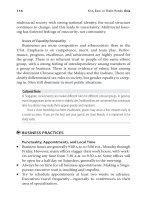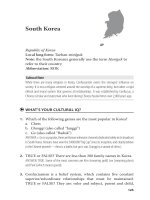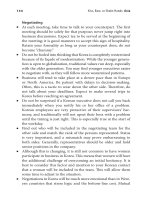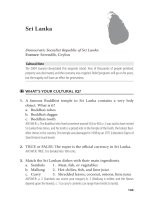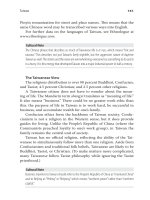How to Understand Business Finance, Second Edition_10 docx
Bạn đang xem bản rút gọn của tài liệu. Xem và tải ngay bản đầy đủ của tài liệu tại đây (180.58 KB, 15 trang )
152 How to Understand Business Finance
It is only worth borrowing to expand a business if the internal
return on investment (ORA or RONA) is expected to be signifi cantly
higher than the interest rates payable on new borrowings.
going concern convention The accounting convention which
requires that unless stated otherwise, accounts are drawn on the
basis that the business will continue to operate indefi nitely.
goodwill When a business is sold, the price paid is usually
greater than the total asset value as shown on the balance sheet.
The diff erence, which represents the buyer’s expectation that it
will generate profi ts in future, is called goodwill, and is put among
the fi xed assets of the buying company’s balance sheet. Goodwill
is usually depreciated over the fi rst few years after the purchase.
gross margin Gross profi t. Sales less cost of sales, less factory
overheads in a manufacturing business. GPM or manufacturing
margin.
gross profi t See gross margin.
historical cost The actual cost of buying an asset at the time it
was purchased. Normal accounting values all assets at historical
cost (less accumulated depreciation) rather than at their current or
replacement cost. In times of high infl ation, current cost
accounting may be used, but this has certain anomalies since
usually fi xed assets are valued at current cost, and inventories at
historical cost, and the sum is not fully meaningful.
income statement (US) Profi t & Loss account (UK). A summary
of the income and expenses of a business during an accounting
period, eg a year.
incremental cost The extra cost associated with an action, eg
hiring a staff member or producing another unit.
153 Glossary of Financial Terms
intangible assets Non-physical assets of the company, such as
patents, trademarks, goodwill and know-how.
interest cover Operating profi t divided by interest payable. A
measure of safety, the ability of the business to service its loans.
internal rate of return (IRR) The discount rate at which the net
present value of a project is zero. Found by trial and error. Because
of the nature of mathematics, some projects have two diff erent
IRRs, each of which gives zero net present value.
investments Money invested in other companies, deposited in the
bank, or otherwise used to generate income of a non-trading nature.
IRR See Internal Rate of Return.
junk bonds Bonds issued by companies with a very small asset
base, consequently off ering a high-risk investment, typically with
high interest.
leverage (US) See gearing (UK).
liabilities The value of goods, services and loans provided to
the business (not by shareholders) which it must repay one day.
Those due for repayment within 12 months are current or short
term; all others are long term. See also short-term liabilities,
long-term liabilities.
Traditionally, shareholders’ funds have been seen as liabilities
of the business, because if the business was liquidated it would
owe them back to the shareholders. But when people talk of the
liabilities of the business, they usually mean the other liabilities,
as described above.
LIFO Last In First Out. A method of costing inventory. See also
FIFO.
154 How to Understand Business Finance
liquidity The ability of a business to pay the costs and expenses
that it needs to pay in the near future. A crude measure is the
quick ratio or acid test. Balance sheet measures of liquidity do not
indicate the full extent of the company’s short-term cash
requirements, because items like salaries not yet incurred, and
materials ordered but not yet received, may add signifi cantly to
the short-term cash requirements shown in the books.
long-term liabilities Long-term debt. Loans and other debts of
the business that are not due for payment within the next year.
loss When the costs and expenses during a period are greater
than the sales revenue, the business makes a loss, and the
shareholders’ equity is reduced by the amount of the loss.
management accounting The production of fi nancial
information for internal use, to support management decision
making. Management accounts include budgets, cash fl ow
forecasts, product-by-product cost analyses and so forth. The
emphasis in management accounting is on having useful
information at the right time. This is diff erent from fi nancial
accounting, where the emphasis is on accuracy and fi tting legally
defi ned ways of presenting the information.
marginal costing Determining the cost of selling one additional
item, usually direct labour and materials, plus any variable
overheads such as sales commission. Marginal costing is useful in
setting prices for special deals such as a non-recurring export
order, but full costing (qv) should be used for most purposes, as it
gives a truer picture of costs.
marketable securities Bonds, bills and shares in other
companies that can be sold readily on stock or fi nancial markets.
Treated as part of current assets and working capital if they are
to be sold within one year; as fi xed assets if kept as an
investment.
155 Glossary of Financial Terms
market leader The company with greatest sales in a given
market is the leader. In some markets the leader’s share is very
high, but in most markets the leader has no more than 15–20 per
cent of the market. Leadership usually carries a strong strategic
advantage. The leader can price 7–12 per cent higher than the next
competitor for a product of the same quality; its advertising is
more eff ective because the product or brand name is more readily
recognised by customers; and the profi tability that comes from
large sales and high prices enables it to stay at the front of product
development and service.
market value The amount for which an asset can be sold.
matching convention An accounting convention that requires
the cost of producing goods or services to be shown in accounts in
the period when they are sold, so that profi t for each period can be
calculated. See timing convention, accrual accounting
materiality convention An accounting convention that allows
non-standard accounting practices to be used if their eff ects are
so small as to be insignifi cant in the context of the whole
business. For a multinational, amounts of millions are sometimes
not material!
money measurement convention An accounting convention
from which accounts record only events and items that can be
described in money value terms. ‘Our people are our greatest asset’
is nonsense in accounting terms, because people cannot be valued
and included on the balance sheet.
net asset cash fl ow The net cash used or generated by increases
and decreases in assets and non-interest-bearing liabilities.
net assets Total assets less all non-interest-bearing debts. The
total investment in the business fi nanced by shareholders’ equity
and interest-bearing debt.
156 How to Understand Business Finance
net assets per share Net assets divided by the number of shares
issued.
net book value The value of fi xed assets less accumulated
depreciation.
net current assets Net working capital. Current assets less
current liabilities.
net income (US) See net profi t (UK).
net present value The sum of present values of all the cash
fl ows projected over the life of a project.
net profi t (UK) Net income (US). The profi t after interest and
tax, available for dividends or retention in the business. Note that
the existence of profi t does not guarantee the availability of cash.
net realisable value The value that would become cash if the
asset were sold.
net working capital Current assets less current liabilities. The more
interest-free credit a company gets from suppliers, tax authorities etc,
the less money it needs to provide (from shareholders or loans) to
fi nance its working capital needs. In a few kinds of business, cash from
sales is received before purchases and expenses have to be paid, and
working capital may be negative. This can happen in supermarkets and
airlines, and provides a fund of customer-fi nanced money.
net worth The net book value of the shareholders’ equity; total
assets less all liabilities.
NPV See Net Present Value.
operating profi t PBIT (UK), EBIT (US), also given many
company-specifi c names, eg MAUI (AT&T), net contribution
157 Glossary of Financial Terms
(Abbott), TP (Unilever). Sales revenue less cost of sales, selling and
operating expenses. The amount of money available to cover
interest expenses, taxes, and provide a return to the investors.
This is the level of profi t managed by most managers, who do not
control the fi nancing of their operations and therefore whose
results should be measured before interest.
operating return on assets ORA, RONA. The internal return on
investment of the business; operating profi t divided by (net) assets.
opportunity cost The notional cost (loss of earnings) that
results from not making alternative use of resources. For example,
with idle factory space, one opportunity cost of an expansion of
machinery into the space is the rental income that would be
earned if the space were rented to a third party. Another might be
the interest that could be earned on the money invested in
machinery, if instead it was deposited in the bank.
ORA (Operating Return on Assets), see return on net assets.
other income Income from subsidiary companies, investments,
royalties etc that do not form part of the principal trading activity
of the company.
overheads (UK) Burden (US). Expenses of the business that do
not contribute directly to the value of the product or service
provided. Generally, fi xed costs.
owners’ equity Net worth. The total of share capital and
reserves. The total funds invested by shareholders for the
purchase of shares, and profi ts reinvested by the company. Total
assets less total liabilities.
P&L See Profi t and Loss account.
payables (US) See creditors (UK).
158 How to Understand Business Finance
payables’ days (US) See creditors’ days (UK).
payback period The time needed for cash infl ows for a project
to exceed the cash outfl ows incurred at the start, so that net cash
fl ow to date becomes positive. If the present values of future cash
fl ows are calculated, payback may take far longer than on the
crude fi gures.
PBIT Profi t before Interest and Tax. See operating profi t.
P/E ratio See price/earnings ratio.
prepayments Goods or services that the company has paid for
but not yet received; these are a current asset.
present value The value in today’s terms of a cash fl ow at a future
time, discounted at an appropriate rate to refl ect the alternative use
to which funds could be put now. See time value of money.
price/earnings ratio The market price of a share, divided by the
earnings per share. A measure of how long, at the current rate of
earnings, a shareholder has to wait for his earnings (whether paid
out as dividends or retained) to total the current price of the share.
A kind of rough payback per share bought today.
prime cost The direct cost of labour and materials used to
produce the product or deliver the service.
profi t The increase in value of a business over a period. When
used without qualifi cation, it may refer to contribution, gross
profi t, operating profi t, earnings (US) or profi t (UK) before tax, or
even net income (US) or net profi t (UK). Profi t occurs when sales
revenue exceeds costs and expenses. It has no automatic short-
term connection with cash fl ow.
profi tability Operating profi t divided by sales revenue × 100.
Also sometimes used to refer to return on investment, ROI.
159 Glossary of Financial Terms
Profi t and Loss (P&L) account (UK) Income statement (US). A
summary of the income and expenses of a business during an
accounting period, usually a year.
prospectus A document put out by a company wishing to raise
fi nance through the sale of shares. Typically it will give the
company’s recent history, and explain why it needs the extra
funds and how they will represent a sound investment.
provisions When goods or services have been received by a
company, but have not yet been invoiced, the expense is shown as
a provision. Provisions may also be made for uncertain events
such as the occurrence of bad debts, and taxes not yet assessed.
They depend on the accrual accounting concept.
prudence convention An accounting convention which
requires that all possible costs are taken into account, but sales are
only accounted for when invoiced.
qualifi ed report See auditors’ report.
quick ratio (UK) Acid test (US). Liquid assets (cash + receivables/
debtors) divided by current liabilities (payables/creditors + loans
due inside one year). A crude measure of liquidity.
ratio analysis Ratios between balance sheet items or P&L
account items often provide an insight into the level of risk in a
company, its eff ectiveness at generating profi t for the
shareholders, and so forth. The simple calculation of these ratios,
usually by dividing one number by another, and their
interpretation, is ratio analysis.
receivables’ days A measure of the average time taken for credit
customers to pay for their purchases. Accounts receivable divided
by the average daily rate of sales.
160 How to Understand Business Finance
relevant range The range of values over which cost analysis is
valid because costs behave uniformly, in drawing break-even
graphs.
replacement value The cost of replacing an asset with a similar
new one.
reserves See retained earnings.
retained earnings Reserves, retentions, ploughbacks. The
amount of past profi ts that have not been paid out as taxes or
dividends, but kept in the business to increase the shareholders’
equity.
return on assets (ROA) ROTA, ROGA. Net profi t (UK) or net
income (US) divided by total assets (= fi xed assets + current assets).
return on capital employed ROCE.
return on equity (ROE) Net income/net profi t divided by total
shareholders’ equity. A measure of the eff ectiveness of the
business in utilising shareholders’ funds to generate wealth. It
does not tell you how much of the profi t was paid out in
dividends, and how much was retained as reserves.
return on investment (ROI) A measure of the ability of the
business to use the money invested in it to generate profi ts. A
loosely defi ned phrase, which may be used to refer to almost any
return ratio, and sometimes referred to as profi tability.
return on net assets (RONA) (UK) ORA (US). Operating profi t
divided by net assets. The key measure of operating management
performance. It removes the eff ects of fi nancing decisions and tax
(not usually controlled by the operating manager) and shows the
ability of the business to cover interest charges and use loan
fi nancing. It also shows the inherent profi tability of the business.
See also operating return on assets.
161 Glossary of Financial Terms
return on sales (ROS) Profi t or earnings as a percentage of sales.
This examines performance in relation to the bottom line (profi t
or earnings).
return on shareholders’ funds (ROSF) Return on equity (ROE).
ROA See Return on Assets.
ROCE Return on Capital Employed.
ROE See Return on Equity, return on shareholders’ funds.
ROGA (Return on Gross Assets), see return on assets.
RONA See Return on Net Assets.
ROS See Return on Sales.
ROSF See Return on Shareholders’ Funds.
ROTA (Return on Total Assets), see return on assets.
sensitivity analysis Analysis of a new project or an existing
business to see the relative sensitivity of profi ts and cash fl ows to
changes in various factors such as sales volume, interest rates,
labour costs etc.
share capital The money invested in the business by
shareholders.
shareholders (UK) Shareowners (US). The owners of the
business, who receive a return on their investment through
dividends paid to them, or through the growth in market value
of their shares. They risk not receiving dividends, and losing
some or all the value of their investment, if the company
performs badly.
162 How to Understand Business Finance
shareholders’ wealth The market value of the company’s
shares. Values rise when the company reports good, steady and
growing profi ts; when results are consistently in line with the
company’s own predictions; and when present or potential
shareholders expect them to rise. They fall for the converse
reasons. The market price of shares has no direct link to the asset
value of the company as shown by its balance sheet.
share price The price of the company’s shares on the stock
markets.
share surplus Money paid by shareholders when buying newly
issued shares, in excess of the face or ‘par’ value of the share.
short-term liabilities Amounts that the business must pay
within one year, shown on the balance sheet. They do not give a
true indication of the fi nancial commitments of the business,
because such things as lease agreements, salary bills and supply
contracts may require substantial resources in the near future, but
do not show in the balance sheet as liabilities until the services
are received. See also liabilities.
standard costing The process of allocating a nominal cost to
goods or services to allow pricing and other decisions to be made.
When the actual costs incurred are higher or lower than the
standard, the diff erence is shown on the P&L account as under- or
over-recoveries.
stock Stocks of raw materials, work in progress, fi nished goods
and spare parts.
strategic planning Planning related to the long-term goals and
performance of the business. Frequently begins with SWOT
analysis.
subsidiary company A company, 50 per cent or more of whose
shares are owned by the holding company.
163 Glossary of Financial Terms
SWOT analysis The detailed consideration of the internal
Strengths and Weaknesses of the business, and the Opportunities
and Threats it faces from the outside. Internal scanning is often
done by function, eg research and development, fi nance,
operations, marketing, sales etc. Outside scanning may look at
technology, markets and demographics, competitors, legal
changes, politics locally and in other countries, and so on.
tangible assets Physical possessions of the business. See also
intangible assets.
time value of money The concept that money in the hand today
is worth more than the same amount received in the future,
because it could be put to work earning compound interest for the
period between. Even without infl ation, the present value is
higher than the future value if there are opportunities to invest.
timing convention An accounting con vention that recognises
only those events within a set period as being relevant to the
accounts for that period. See accrual accounting, matching
convention.
total assets All the valuable possessions of the business.
Includes tangible and intangible assets, both current and fi xed.
trading cash fl ow The cash fl ow resulting directly from the
company’s trading activity. Net profi t adjusted for any non-cash
expenses or incomes, eg depreciation.
unit cost The total cost of an output divided by the number of
units. Units may be physical, eg cars, or not, eg covers in a
restaurant, bed-nights, passenger-miles.
value added Sales revenue less all bought-in goods and services.
164 How to Understand Business Finance
variable costs Costs which change in direct proportion to sales
revenue, over their relevant range (qv). Example: cost of goods
sold in a retail business.
weighted average cost of capital (WACC) The percentage charge
levied for money tied up in a company. See also economic profi t.
working capital The value of assets used (consumed) in the
main trading activities of the company, eg cash, raw materials,
work in progress, credit given to customers. In many businesses
the investment in working capital is considerably greater than
that needed in fi xed assets.
zero-based budgeting A system of budgeting in which
historical spending patterns are explicitly ignored, and each
budget item is justifi ed de novo at the level proposed for the
coming period.
With over 42 years of
publishing, more than
80 million people
have succeeded in
business with thanks
to Kogan Page
You are reading one of the thousands of books
published by Kogan Page. As Europe’s leading
independent business book publishers Kogan Page
has always sought to provide up-to-the-minute books
that offer practical guidance at affordable prices.
www.koganpage.com
165
166
THIS PAGE IS INTENTIONALLY LEFT BLANK




